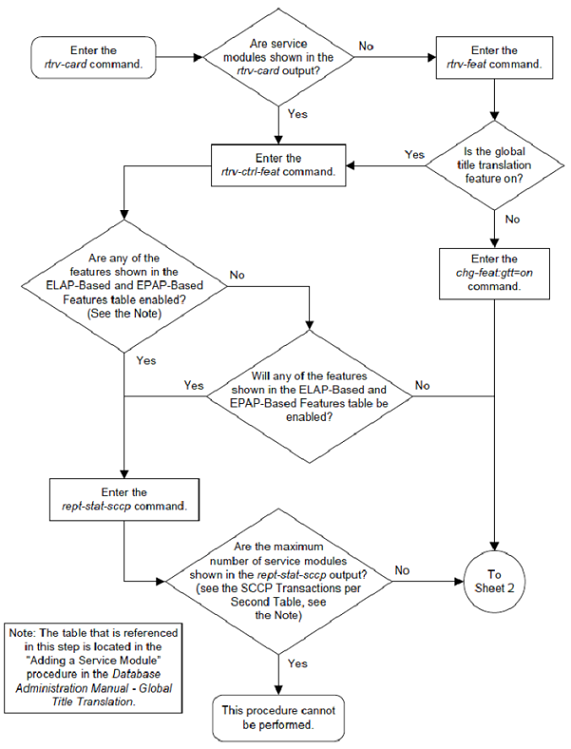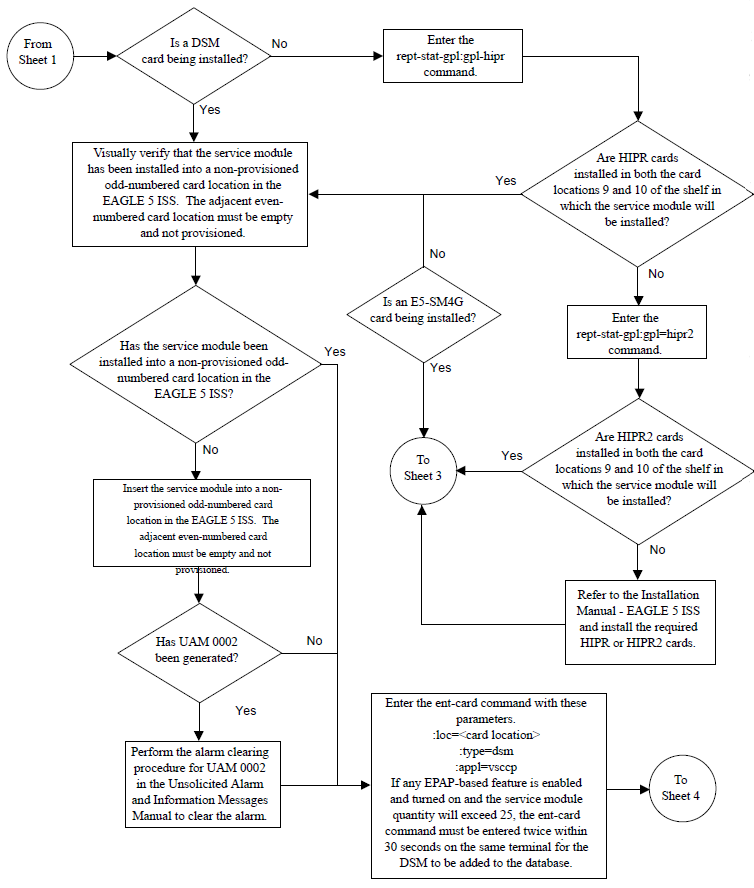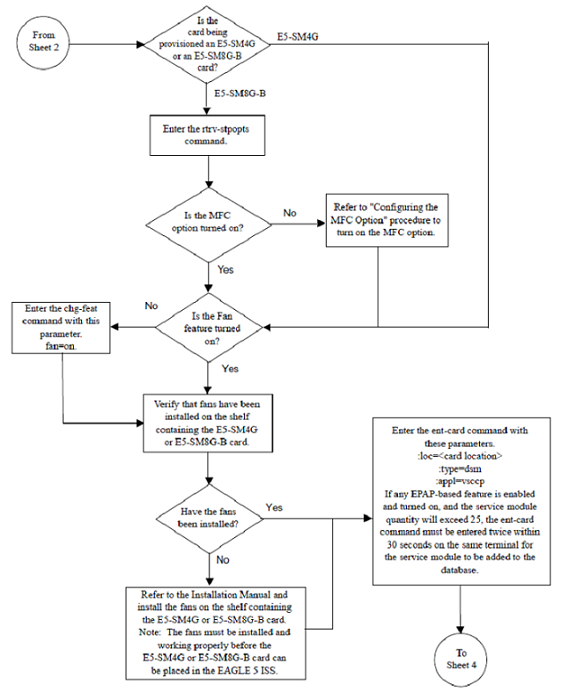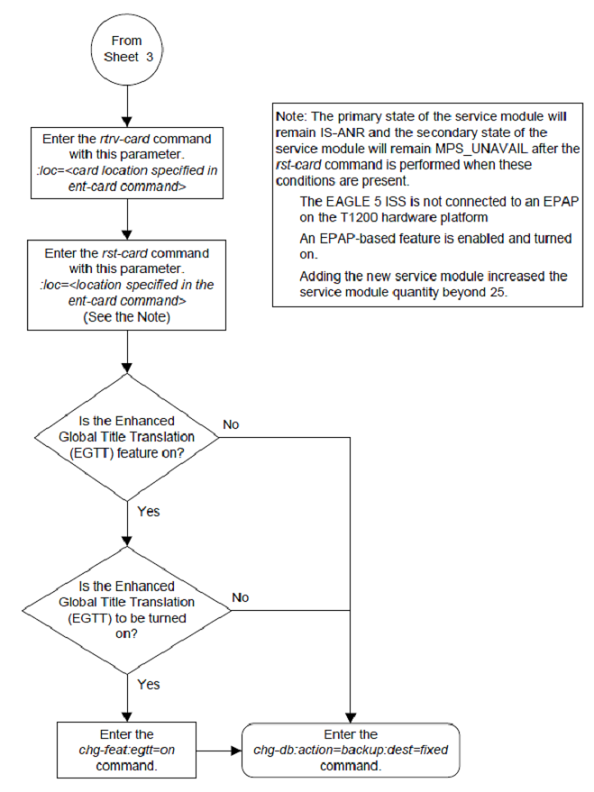4 Configuration of Supported Features
This chapter describes the procedures for configuring the features supported on SLIC card(s).
Adding a LIM-E1 Card
The LIM-El card is provisioned as either an E1 card or a channel
card in the database using the ent-card command. The card being
provisioned in the database can be one of these cards shown in unresolvable-reference.html#GUID-D58B6B3D-C4C1-4B18-8056-0FD6CB2CEB09__V2199083.
The ent-card command uses these
parameters.
:loc – The location of the card
being added to the database.
Note:
The HC-MIM can be inserted only in a odd-numbered card location. The HC-MIM will not power up if it is inserted in an even-numbered card location. All the E1 backplane cabling should be removed from the B connector for the slot that the HC-MIM will occupy.The HC-MIM occupies two card locations, so the even numbered card location adjacent to the odd numbered slot where the HC-MIM has been inserted must be empty, as shown in unresolvable-reference.html#GUID-D58B6B3D-C4C1-4B18-8056-0FD6CB2CEB09__V2199086. The HC-MIM is connected to the network through the odd numbered card slot connector.
Table 4-1 HC-MIM Card Locations
| Location of the HC-MIM | Empty Card Location | Location of the HC-MIM | Empty Card Location |
|---|---|---|---|
|
Slot 01 |
Slot 02 |
Slot 11 |
Slot 12 |
|
Slot 03 |
Slot 04 |
Slot 13 |
Slot 14 |
|
Slot 05 |
Slot 06 |
Slot 15 |
Slot 16 |
|
Slot 07 |
Slot 08 |
Slot 17 |
Slot 18 |
The E1, E1/T1 MIM and E5-E1T1 cards occupy one card location. These cards can be placed in any card location except for even numbered card locations whose adjacent odd numbered card location is occupied by a card that occupies two card locations.
:type – The type of card being
added to the database. For this procedure, the value of this parameter is lime1 (E1 card) or limch (channel
card).
Note:
The HC-MIM and E5-E1T1 card cannot be provisioned as a channel card.:appl – The application software
that is assigned to the card. For this procedure, the value of this parameter is
either ccs7itu
or ss7ansi.
The shelf to which the card is to be added must
already be in the database. This can be verified with the rtrv-shlf command. If the shelf
is not in the database, see the Adding a Shelf procedure in Database Administration - System Management User's Guide.
The examples in this procedure are used to add the LIM-E1 cards in card locations 1201, 1202, 1203, 1204, 1211, and 1212 to the database.
Adding a LIM-T1 Card
The LIM-T1 card is provisioned as either a T1 card or a channel
card in the database using the ent-card command. The card being
provisioned in the database can be one of these cards shown in unresolvable-reference.html#GUID-4DDAC8D1-8068-4B5F-B2A5-D6DCB412DAD7__V2199101.
The ent-card command uses these
parameters.
:loc – The location of the card
being added to the database.
Note:
The HC-MIM can be inserted in an odd-numbered card location only. The HC-MIM will not power up if it is inserted in an even-numbered card location. All T1 backplane cabling should be removed from the B connector for the slot that the HC-MIM will occupy.The HC-MIM occupies two card locations, so the even numbered card location adjacent to the odd numbered slot where the HC-MIM has been inserted must be empty, as shown in unresolvable-reference.html#GUID-4DDAC8D1-8068-4B5F-B2A5-D6DCB412DAD7__V2199104. The HC-MIM is connected to the network through the odd numbered card slot connector.
Table 4-3 HC-MIM Card Locations
| Location of the HC-MIM | Empty Card Location | Location of the HC-MIM | Empty Card Location |
|---|---|---|---|
|
Slot 01 |
Slot 02 |
Slot 11 |
Slot 12 |
|
Slot 03 |
Slot 04 |
Slot 13 |
Slot 14 |
|
Slot 05 |
Slot 06 |
Slot 15 |
Slot 16 |
|
Slot 07 |
Slot 08 |
Slot 17 |
Slot 18 |
The E1/T1 MIM and E5-E1T1 card occupies one card location. These cards can be placed in any card location except for even numbered card locations whose adjacent odd numbered card location is occupied by a card that occupies two card locations.
:type – The type of card being
added to the database. For this procedure, the value of this parameter is limt1 (T1 card) or limch (channel
card).
Note:
The E5-E1T1 card cannot be provisioned as a channel card.:appl – The application software
that is assigned to the card. For this procedure, the value of this parameter is
either ccs7itu
or ss7ansi.
:force – Allow the LIM to be added to
the database even if there are not enough service modules in
the EAGLE to support the number of
LIMs in the EAGLE. This parameter is obsolete and is no longer
used.
The shelf to which the card is to be added must
already be in the database. This can be verified with the rtrv-shlf command. If the shelf
is not in the database, see the Adding a Shelf procedure in Database Administration - System Management User's Guide.
The examples in this procedure are used to add the LIM-T1 cards in card locations 1215 and 1216 to the database.
Adding a Service Module
This procedure is used to add a service module to support the
Global Title Translation or Enhanced Global Title Translation feature to the
database using the ent-card command.
- E5-SM8G-B
- SLIC
The card that is used as a service module depends on the GTT
related features that are being used and the features that will enabled after
this procedure is performed. The features or feature combinations shown in **INTERNAL XREF ERROR** show the
type of card that must be installed in the EAGLE to meet the minimum EAGLE
performance requirements. The features that are currently being used by the
EAGLE are shown in the rtrv-feat or rtrv-ctrl-feat command outputs.
Table 4-5 Service Module and Feature Combinations
| Card | Features |
|---|---|
|
E5-SM8G SLIC |
Any of these features:
or GTT and EGTT (if the Enhanced Global Title Translation feature is on) in combination with at least 2 of these features:
|
The E5-SM8G-B can be inserted only in the odd numbered card slots of the control or the extension shelf. Slots 09 and 10 of each shelf contains the HIPR2 card, thus the E5-SM8G-B cannot be inserted in slot 09 and 10. The E5-SM8G-B can be inserted in the control shelf, but only in slots 01, 03, 05, 07 and 11. The E5-SM8G-B occupies two card slots, so the even numbered card slot adjacent to the odd numbered slot where the E5-SM8G-B has been inserted must be empty, as shown in unresolvable-reference.html#GUID-FA0B3F5F-E5F4-41DD-AF10-AF282BECCFFF__TABLE_4820C98F23E84C919125FF4BA67B21BC. The E5-SM8G-B is connected to the network through the odd numbered card slot connector. The E5-SM8G-B requires two HIPR2 cards in the shelf where it is installed.
The SLIC can be inserted only in the odd numbered card slots if it is
provisioned with the type=dsm parameter of the
ent-card command. The SLIC can be inserted
in odd or even numbered card slots if it is provisioned with the type=slic parameter of the ent-card command.
Table 4-6 Card Locations
| Location of the E5-SM8G-B | Empty Card Location |
|---|---|
| Slot 11 | Slot 12 |
| Slot 13 | Slot 14 |
| Slot 15 | Slot 16 |
| Slot 17 | Slot 18 |
The ent-card command uses these
parameters:
:loc – The location of the card being added to the database.
:type – The type of card being
added to the database. The value of this parameter is dsm or slic.
:appl – The application software
that is assigned to the card. The value of this parameter is vsccp.
:data – The data type of the
card when running the EPAP Data Split feature and the Dual ExAP Configuration
feature. The value of this parameter is dn or
imsi for the EPAP Data Split feature and
ELAP, EPAP
or GTT for the Dual ExAP Configuration feature.
The shelf to which the card is to be added must already be in the
database. This can be verified with the rtrv-shlf command. If the shelf is not in the database, perform
the "Adding a Shelf" procedure in Database Administration –
System Management User's Guide.
The card cannot be added to the database if the specified card location already has a card assigned to it.
Note:
If you want to add an E5-SM8G-B or SLIC card as the service module, verify the temperature threshold settings for the appropriate card by performing the "Changing the High-Capacity Card Temperature Alarm Thresholds" procedure in Database Administration - SS7 User's Guide. The E5-SM8G-B card also requires a fan tray.Figure 4-1 Add a Service Module - Sheet 1 of 4

Figure 4-2 Add a Service Module - Sheet 2 of 4

Figure 4-3 Add a Service Module - Sheet 3 of 4

Figure 4-4 Add a Service Module - Sheet 4 of 4

Adding an IPSG Card
This procedure is used to add an IPSG card to the database using the ent-card command. An IPSG card is an E5-ENET-B or SLIC
card that is running the IPSG application.
The ent-card command uses these
parameters.
:loc – The location of the card being
added to the database.
:type – The type of card being added
to the database. For this procedure, the value of this parameter is enet for an E5-ENET card and enetb for E5-ENET-B. When provisioning the SLIC,
the card type is slic.
:appl – The application software that
is assigned to the card. For this procedure, the value of this parameter is ipsg.
:force – If the global title
translation feature is on, the force=yes parameter
allows the IPSG card to be added to
the database even if the current SCCP
transactions-per-second threshold is unable to support the additional SCCP transaction-per-second capacity
created by adding the IP card. This
parameter is obsolete and is no longer used.
Card Slot Selection
The E5-ENET card can be inserted into any card slot, except for card slots that must remain empty to accommodate dual-slot cards, slots 09 and 10 in each shelf, and slots 1113 through 1118.
To provision a E5-ENET card, the shelf containing the E5-ENET card must
have HIPR2 cards installed in slots 9 and 10 in that shelf. If HIPR2 cards are not
installed in the shelf that the E5-ENET card will occupy, the E5-ENET card will be
auto-inhibited when the E5-ENET card is inserted into the shelf. Enter the rept-stat-gpl:gpl=hipr2 command to verify whether or
not HIPR2 cards are installed in the same shelf as the
E5-ENET card being provisioned in this procedure.
Configuring DEIR on SLIC
This procedure configures the EIR S13/S13’ Interface Support (DEIR) feature on the SLIC card to provide network redundancy. Step 5 through step 8 configure the DEIR connection.
ENUM Configuration
Example 4-1 Additional Configuration Commands
The ENUM Options commands (chg-enumopts, rtrv-enumopts) are
used to change and display ENUM-specific data in the ENUM Options table (ENUMOPTS).
The rept-stat-enum command is used to
display the overall status of the ENUM feature on the EAGLE.
Provisioning SIP Cards
- Enter
ent-card:loc=<SM card location>:type=dsm:appl=siphc:data=epapcommand to provision the SIP card for EPAP. - Enter
ent-card:loc=<SM card location>:type=dsm:appl=siphc:data=elapcommand to provision the SIP card for ELAP.